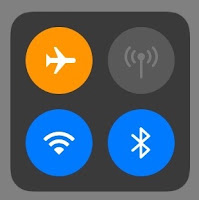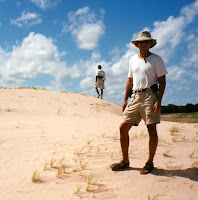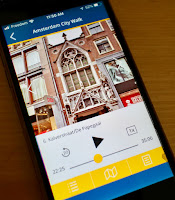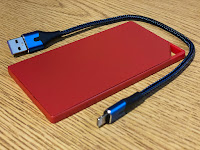Travel and Leisure
I've Googled "travel essentials" a number of times, and am always shocked at what I see on their lists. e.g. travel steamer, vacuum packer, a portable fan... Really? You'd need a whole other piece of luggage if you followed that advice. After a perusing a few of these "must have" lists, you quickly realize that they are merely paid advertising for items that are barely related to travelling. That's why I thought I'd jot down a set of "real" travel essentials - ones that actually make a difference and can be easily brought along with you. All of the items below I take with me on almost every European trip, and fit in my carry-on sized primary article and personal item.
For the plane
I like to have the stuff I will need during the flight handy, and take it out when I arrive at my seat, so that I don't have to touch my luggage again until we land.
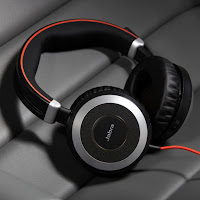 |
| Image credit: Jabra.ca |
- Noise-cancelling headphones. No, not those ear-bud types, but over-the-ear, active noise-cancelling ones (Edit: these are now a game-day decision for me; if I manage to get into business class, they supply decent ones). You don't need to spend the big bucks on Bose ones, but they are amazing headphones. I was lucky enough to get a pair from Jabra through my old job, and they are not only great at blocking out the airplane engine drone, but are great for watching movies on my...
- iPad. Sure, most airlines have in-seat TVs, but sometimes you just need to catch up on Netflix' "Stranger Things" instead. Also, some airlines (e.g. Air Canada Rouge) now rely on their passengers to use their own devices to download an app to stream their on-board entertainment. At your destination(s), the iPad is essential to research your next day's outing and restaurants.
- Travel blanket. She brings her own along, as sometimes the ones available in coach are tiny, or worse, you have to pay for them. A nice to have as well, when you decide to have a little picnic in the gardens at the Forum in Rome.
 In-seat amenity kit. If you're lucky enough to be in Business or First class, they'll give you most of this stuff in a handy little pouch that you can reuse, but any small bag will suffice. I got mine on Twilight Zone's ill-fated Nightmare at 30,000 feet flight to Tel Aviv (through the miracle of TV magic, I survived the crash). It keeps all of those little things that you might want, together in a tidy package that slips into the seat pocket. I've put into mine the following things I've collected on other flights, but you can get this stuff online or at a drugstore:
In-seat amenity kit. If you're lucky enough to be in Business or First class, they'll give you most of this stuff in a handy little pouch that you can reuse, but any small bag will suffice. I got mine on Twilight Zone's ill-fated Nightmare at 30,000 feet flight to Tel Aviv (through the miracle of TV magic, I survived the crash). It keeps all of those little things that you might want, together in a tidy package that slips into the seat pocket. I've put into mine the following things I've collected on other flights, but you can get this stuff online or at a drugstore:
- antiseptic cleansing wipes - you wouldn't believe the germs that are on that seat table and lap belt
- pen - always handy for customs and immigration forms
- reading glasses (for old guys like me)
- earplugs and eye mask; her mask is molded so that it doesn't touch her eyelids/eyelashes while in place
- hand & face lotion - the lack of humidity on planes dries you out
- face spritzer and refreshing wipe - to help reinvigorate you before you land
- small container for any pills required (e.g. melatonin/Zopiclone, Advil, etc.)
- travel toothbrush - there's nothing like being able to brush the scum off your teeth after a 9 hour red-eye to Europe
Doing laundry
Even when travelling for two weeks or more, most travel pros advocate taking only enough clothes for about a week, and then using either hotel laundry services or going to the laundromat yourself. But do you really need to pay the hotel €3.50 to get one pair of socks washed? Instead, we bring this washing kit with us so that we can hand wash some socks and undergarments to get us through until a real washing is required.
The clothesline does not require clothes pegs, and with suction cups as well as hooks, you can hang it almost anywhere. The Tide pen works great for spot cleaning, and for items worn once, I give them a spritz with the Downy fabric freshener/wrinkle remover, and hang in the closet for a second use. A stretchy, mesh bag is good to keep your dirty items together until you get a chance to launder them. You can use the hotel's shampoo to wash your garments in the sink, but we bring along these Tide minis, as well as laundry soap sheets for the Airbnbs that have a machine. I tried the
Travelon laundry soap sheets, but found that you needed to use so many, and switched to Tide. I also picked up a universal sink stopper in case your hotel room's sink doesn't have the ability to collect water (it has happened). I had a little pouch that I picked up along the way somewhere, so it keeps everything to do with laundry all in one place. But what if you have a larger garment that is too big to wash in the tiny sink on your river cruise? There are
wash bag products out there, or you could simply use a...
Ziploc bags
 |
| Image credit: Ziploc.com |
If you can't think of a use for these handy bags, then you're not thinking hard enough. Small sandwich-sized ones are great for taking snacks along on your day tour. Large freezer-size bags are great for sneaking a couple of croissants from the breakfast bar for a mid-morning break.
Really big Ziplocs can be used as wash bags; put in your items, water, and a laundry soap tab, and agitate. Bigger ones can also be used to compress bulkier items like sweaters for more efficient packing. They are also great for packing your wet swimsuit on your last day at the beach.
Electronics stuff
In addition to the iPad and noise-cancelling headphones, I covered most of the gadgets that I usually bring travelling in
a previous post. But one that you should really make sure you have with you all the time, is a
pocket power bank. Especially if your primary camera is your smartphone, the need to keep it charged is even more paramount. I'd argue that you use your iPhone more when on vacation than you do at home. It is your mapping device, travel organizer, restaurant guide, currency converter, language translator, and camera - when it dies, what will you do?
Update: I was using one that was only 2800 mAh, which technically isn't enough juice to recharge my new iPhone 12 Pro, so I got a new, slim 5000 mAh one, pictured.
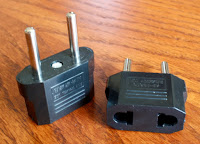
Of course you need to connect to the local power to charge your devices, so you need
power adapters to convert your North American plugs to the typical European two round pin sockets called Type C. Unless you are going to the UK, you will only need this one adapter, as it is widely used throughout Europe. Often the socket is recessed in the wall; make sure you get adapters that will fit into the round depression area. The Swiss one is like a flattened hexagon/octagon; if you get ones that will fit those sockets (pictured), you'll be covered for 95% of Europe. As indicated in my
River Cruising 101 post, your electronic devices' power supplies are already capable of handling dual voltages and frequencies; you only need a step-down converter for things like hair irons etc. Even if your ship has North American, 110v outlets, you probably still have a hotel night or two somewhere that will require you to have these adapters.
Here's another tip we give to everyone who goes to Europe -
Rick Steves Audio Tours. You use your own smartphone to listen while Rick guides you around many of the major cities in Europe, and their unique attractions. But we often find that with the two of us on separate devices, we get "out of sync", where I'll be on the Temple of Julius Caesar, when she's still at the House of Vestal Virgins. To avoid this, I now recommend using just one pair of
bluetooth earbuds, so that each person can use one earbud, and then playback from only one smartphone.
Passport wallet
I wasn't going to include this on my list, as I just assumed that everyone automatically used a passport wallet to keep their travel documents and passports together. But on almost every flight, I see someone frantically rifling through their gear looking for their passport and boarding pass as they are trying to get on their plane. I used to use a long, rectangular one, back when we had physical airline tickets, but now, use a small leather wallet, large enough for two passports, and a few travel cards. You're not going to walk around with this everyday, so it doesn't need to hold your day-to-day credit cards and cash; we put the currency that we are not using in it, along with cards we don't need. Pros will tell you to have a photocopy of your passport info with you at all times; I use an
app called Stocard to store an image of my important cards etc. on my iPhone. When travelling, my passport wallet stays in the secret pocket of my shoulder bag, and as soon as we arrive at the hotel, it goes into the safe.
Other optional miscellaneous items
Here are just a few other things we like to have with us, depending on what we think we'll be doing.
- folding tote bag - For that trip to the supermercato to pick up some charcuterie and bottle of wine, or just an environmentally friendly way to pick up souvenirs.
- picnic utensils - This depends on your itinerary and activities, but sometimes we like to have some rudimentary items for that little charcuterie lunch in the park. A Swiss Army knife (if checking baggage) with a corkscrew is handy to have, as it can be used to cut meats and cheeses, or slice a baguette. We have some folding "sporks" as well, in case there is something less finger-food friendly, or simply to stir your coffee. Some collapsible cups round out our picnic package, as drinking wine right out of the bottle is usually frowned upon.
- hand sanitizer and/or soap sheets - You may not have a chance to wash your hands before pulling out your mid-morning snack, so it's great have this handy in you daypack. If you have some water, you can use these small soap sheets for a quick clean up.
- pocket flashlight - Even though your smartphone can be used for this, I like to have a AAA penlight in my bag. It's a throwback to when I was travelling to the Caribbean often, where power outages were frequent, but it's a good idea anywhere, really.
- tea & coffee kit - This also hinges upon what our travel package looks like; of course if we are staying in hotels or on a river cruise, this is unnecessary, but for some more budget accommodations, it is nice to have a cup of tea or coffee when you are up at 5 am due to the timezone change.
- mini first aid kit - Usually just a few band-aids, some Advil/Naproxen, Tums and Imodium; pharmacies seem to be on almost every other corner in Europe, so you don't need vast quantities of stuff.
- plastic bottle belt clips - I'll likely have a small, dual-wall stainless water bottle with me, but this is a good option as well. We find that airlines are now giving out these handy little water bottles during the flight. So rather than let them go to waste, these little clips from eBay allow you to take them with you, either clipped to your belt or backpack. Another option is to use collapsible water bottles (Vapur), as they take up no room when empty, and you can fit them into the mini-freezer compartment to get them icy cold for your day.
No endorsements or fees were received for this post.





















